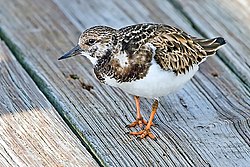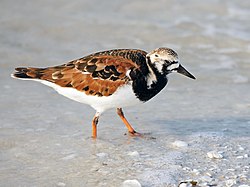| Turnstone | |
|---|---|
 | |
| Ruddy turnstone in nonbreeding plumage | |
 | |
| Black turnstone in winter plumage | |
| Scientific classification | |
| Kingdom: | Animalia |
| Phylum: | Chordata |
| Class: | Aves |
| Order: | Charadriiformes |
| Family: | Scolopacidae |
| Subfamily: | Arenariinae |
| Genus: | Arenaria Brisson, 1760 |
| Type species | |
| Tringa interpres Linnaeus, 1758 | |
| Species | |
| Synonyms | |
| |
Turnstones are two bird species that constitute the genus Arenaria in the family Scolopacidae. They are closely related to calidrid sandpipers and might be considered members of the tribe Calidriini. [1]
Contents
The genus Arenaria was introduced by the French zoologist Mathurin Jacques Brisson in 1760 with the ruddy turnstone (Arenaria interpres) as the type species. [2] [3] The genus name arenaria is from Latin arenarius, "inhabiting sand", from arena, "sand". [4]
The genus contains two species: the ruddy turnstone (Arenaria interpres) and the black turnstone (Arenaria melanocephala). [5] Both birds are waders. Their length is typically between 20 and 25 cm, with a wingspan between 50 and 60 cm and a body mass between 110 and 130g. For waders their build is stocky, with short, slightly upturned, wedge shaped bills. They have white patches on the back, wings and tail. They are high Arctic breeders, and are migratory. Their strong necks and powerful, slightly upturned bills are adapted to their feeding technique. As the name implies, these species overturn stones, seaweed, and similar items in search of invertebrate prey. [6] They are strictly coastal, prefer stony beaches to sand, and often share beach space with other species of waders such as purple sandpipers.







